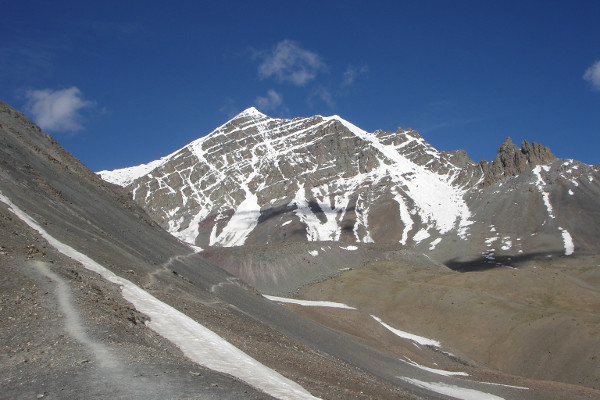Situated in the remote and scenic Ladakh region of north-west India, Stok Kangri is an increasingly popular summit for hikers who wish to undertake a less technical high-altitude trek in the Himalayas.
This is not to say that Stok Kangri is for beginners and underestimate its difficulty though.
Experience on other high altitude climbs as well as a knowledge of how to use crampons and an ice axe is essential to complete this trek as weather conditions and the rapid gain in altitude on summit day often affect even the more experienced hiker.
Stok Kangri Trek
At 6,153m above sea level, Stok Kangri is the highest mountain in the Stok range of the Himalayas. It is situated in the Hemis National Park which is in the Ladakh region of Jammu and Kashmir in India.
Hemis National Park is itself famous for being home to the greatest concentration of snow leopards in the world.
Also known as the ‘Land of high passes’, Ladakh is renowned for its remote and beautiful mountainous regions. It is popular with hikers due to the numerous amazing trekking routes such as the Markha Valley Trek or the Chadar Trek that cross the region.
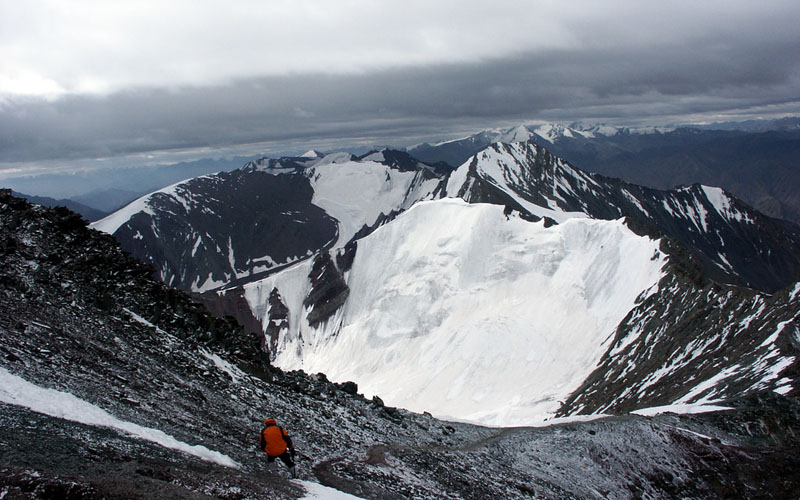
Photo by Mountain Madness
The peak of Stok Kangri, visible from the nearby town of Leh, entices thousands of hikers to attempt its summit every year. The scenery on the trek is typical of a high altitude desert; stark and beautiful. It is an arid landscape of deep valleys rising up to perennially snow-topped peaks. Views from the peak overlook the Zanskar and Karakoram ranges, and on a clear day, K2 can be seen in the distance.
Because the trek is done during the summer months, the daytime temperatures at the lower camps are fairly pleasant and range from 10° to 25°C during the day and average around 10°C at night. From Base Camp upwards to the summit, the temperatures decrease drastically, and the weather becomes more unpredictable. Here, you can expect a range of 10°C to 15°C during the day and anything from 5° to -2°C and less at night time.
There are several approaches to the summit of Stok Kangri, all of which start and end at Leh. The three popular approaches branch off from Leh and approach the summit from different valleys. These approaches ultimately end up re-joining at Mankarmo and from this point, there is one route up and down.
Sightseeing in Leh
The town of Leh is situated at 3,524m above sea level. Spending a few days here to acclimatise before your hike is highly recommended, especially if you are scheduled to arrive in from Delhi which is at sea level.
Leh is scenic and full of history. Pass time sight-seeing whilst acclimatising by exploring the Buddhist monasteries of Shey and Thiksey, or walk around the vibrant markets that were once part of a silk trading route.
You can also take a drive across Khardung La Pass which is one of the highest lying motor passes in the world. It was used historically by horses and camels as a caravan route from Leh to Kashgar in Central Asia and today it is used to carry supplies to Siachen glacier.
Stok Kangri Itinerary
A typical itinerary along the main route via Stok Village would look like this:
Day 1: Arrive in Leh on a flight from Delhi. Check into your hotel in Leh. Stay overnight in the hotel.
Day 2: Acclimatize. Spend the day sightseeing in Leh. Stay overnight in the hotel.
Day 3: Drive from Leh to Stok Village. Begin your trek here, going from Stok Village to Chang Ma. Stay overnight in Chang Ma in tents camping.
Day 4: Trek from Chang Ma to Mankorma. Stay overnight in Mankorma in tents camping.
Day 5: Trek from Mankorma to Base Camp. Stay overnight in Base Camp in tents camping.
Day 6: Base Camp Day. Rest day and training day in Base Camp for acclimatisation and preparation for the upcoming summit bid.
Day 7: Summit bid Day. Base Camp to Stok Kangri summit and return to Base Camp.
Day 8: Return. Head back to Stok Village and drive to Leh.
Popular Stok Kangri Routes
All routes start at Leh (3,524m above sea level). One of the shorter popular routes is to start from Stok Village, which is a short 15km drive from Leh. You will commence your hike here and trek the 5.5km to Chang Ma (3,988m) which is your first overnight stop.
The next day you will trek 3.5km to your next overnight stop at Mankorma (4,320m). From Mankorma it’s 4km to get Base Camp (4,930m) where you will spend the next two days.
The real test comes on the stretch from Base Camp to summit where you will trek 7km to the summit (6,153m) and then 7km back to Base Camp. Your descent is back the way you came up.
Starting at Zingchen
Another popular route that allows for extra acclimatisation preparation starts the trek at Zingchen (3,402m). From Leh, it's a short drive to Zingchen (3,402m) where you will hike 6.5km to stay overnight at Rumbak (3,956m).
The next day is a tough one and you will trek 10.7km from Rumbak, over Stok La Pass (4,855m) and then descend to Mankorma (4,320m) where you will overnight.
The next day your trek will take you to meet up with the main route up and you will trek the 4km to Base Camp to overnight and prepare for summit day.
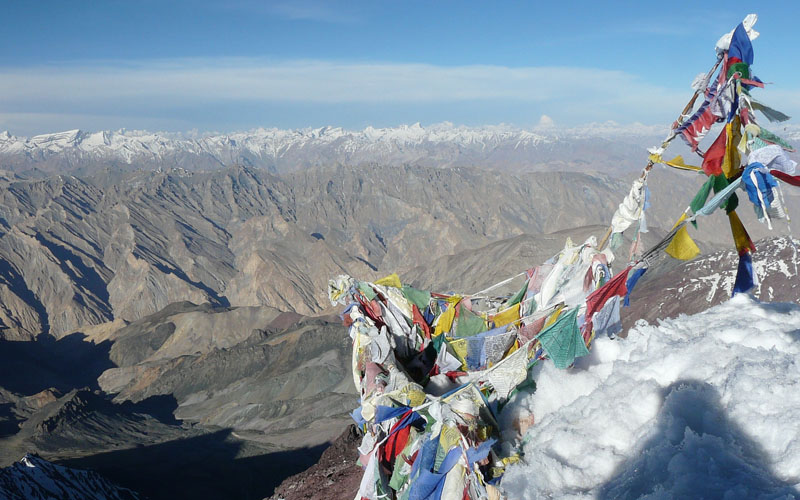
Photo by Peter Lademann
Starting From Chilling
There is another longer route which some people do for extra acclimatisation days if they have the extra time. This one starts the trek from Chilling which is a three hours’ drive from Leh.
This route goes via a town called Skiu and ultimately meets up at Rumbak to join the Stok La acclimatisation route.
It can take up to 5 extra days compared to the other routes.
Please Note: There are no permanent sleeping structures along the routes to the summit and all overnighting is done in tents. A few of the regular tour operators have tents permanently erected at base camp otherwise all tents are carried up by porters or horses and erected daily.
At Base Camp, you will find a tea tent that sells a few basic supplies such as bottled water and snack bars to supplement any additional diet needs you might have.
Stok Kangri Trek FAQ
How do you get to Stok Kangri?
The easiest way to get to Leh is to fly into Delhi and from there, several airlines offer daily flights at reasonable fares from Delhi to Leh. Check with Air India, Jet Airways, Hahn Air Systems or with your travel agent to see what is available.
You can also get to Leh via road but this takes a lot longer as the transport systems can be unreliable and the road is only open during the summer months. From Delhi, you would take a bus to Manali where you would overnight before getting another bus onto Leh. The entire journey via road can take between two and three days but if you have time to spare and a sense of adventure this could be an exciting way to see more of the Indian countryside.
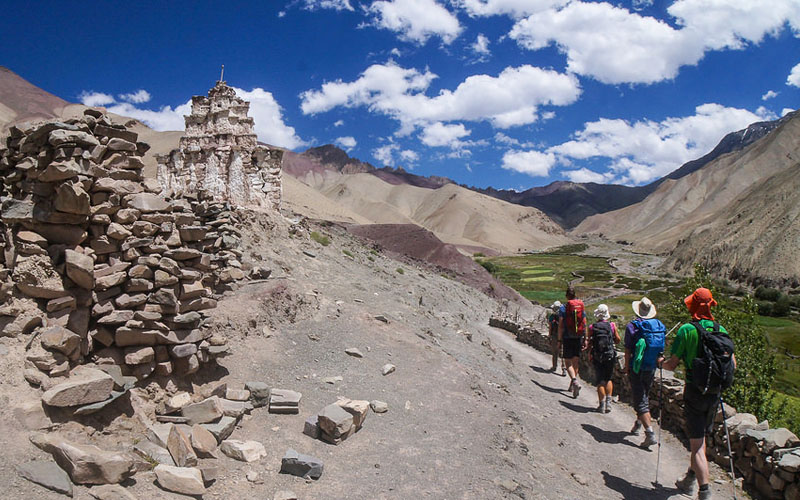
Photo by Steen J. Østergaard
Do you need acclimatisation for Stok Kangri?
Absolutely. Spending a few days in Leh at 3,542m to help your body adjust and rest will help greatly with acclimatisation. Do not rush this part of your summit preparation. Combined with unpredictable weather conditions, mountain sickness that can result from inadequate acclimatisation prior to trekking are the two main reasons that so many hikers fail to reach the summit of Stok Kangri.
Taking one of the longer routes that start from Chilling or Zingchen and follow the Stok La Pass which descends before joining up with the main route for the continued ascension may also help those who wish to extend their acclimatisation time and ascend at a more gradual pace.
The Ladakh region offers many beautiful hikes, for example, the Markha Valley Trek, and considering that the majority of them leave from Leh it is very easy to undertake one of these as a warm-up for Stok Kangri.
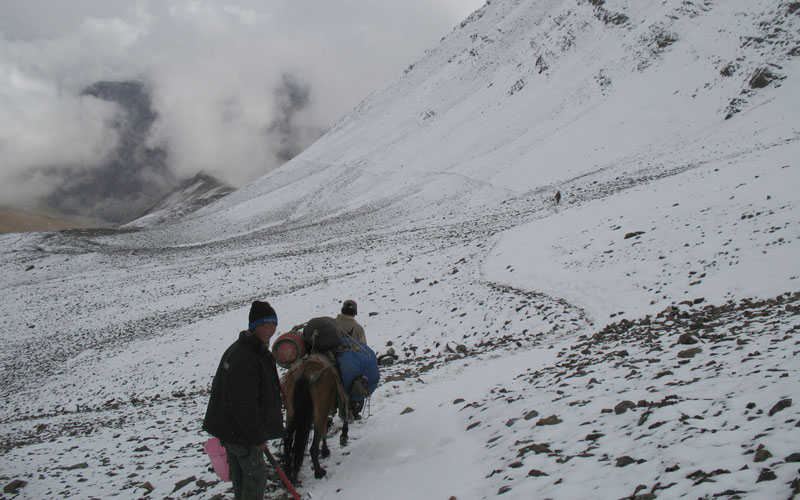
Photo by Mayoor Patal
When is the best time to climb Stok Kangri?
Stok Kangri is best attempted during the summer months from June to September when the routes (except for the summit which is perennially covered) are clear from snow.
Very experienced trekkers can risk adverse weather conditions and attempt the summit late September into October, but an experienced guide is recommended, and the trek should not be underestimated.
Please Note: The route is closed to trekkers over the winter months.
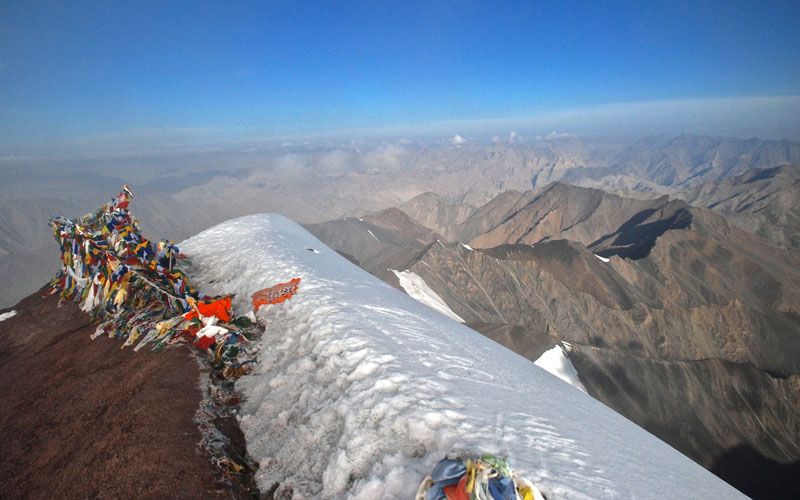
Photo by Mountain Madness
How difficult is the Stok Kangri Climb?
This trek is classified as a difficult climb due to the difficult conditions that you will meet from Base Camp up to the summit. AMS is a very real threat and careful attention should be paid to any symptoms that arise.
Your trek will vary in pace and intensity and might seem deceivingly easy over the first few days on the trek up to base camp. Thereafter the difficulty increases as the terrain becomes more challenging, weather conditions decline, and the air becomes thinner as you head towards the summit.
On the summit day trek, you will negotiate various types of terrain that will include traversing across a slippery glacier, negotiating your way over a section of verglas, picking your way through rocky moraine, and scrambling up snow-covered slopes. This is where your crampons, ice axe and trekking poles might be needed to get you to the summit. Inexperienced hikers might consider roping up for the last stretch when walking the final section of the shoulder to the summit.
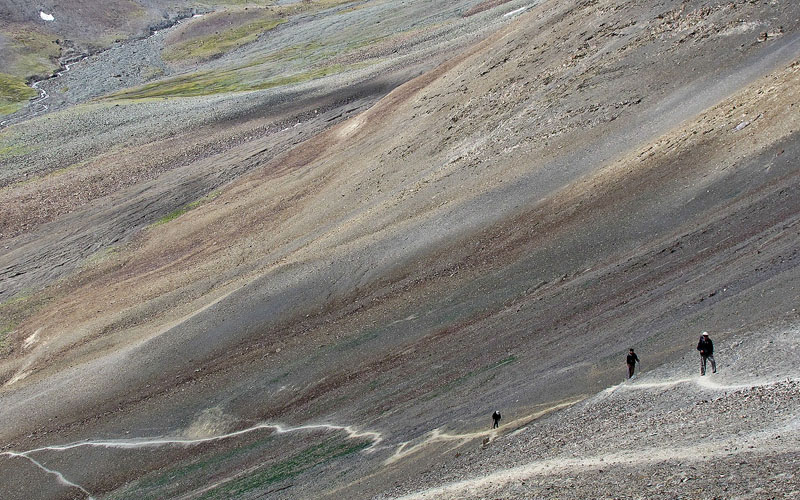
Photo by Matthew Amery
Do you need training to climb Stok Kangri?
Yes, you need some training to climb Stok Kangri. As it is a difficult climb, a good level of fitness and muscle strength, especially in your legs, is required to successfully reach the summit.
Your route to the summit of Stok Kangri trek will involve approximately 4 actual trekking days, each day varying in trekking time from 2.5hrs and up to 11hrs on the summit day.
You will be faced with cold, often freezing nighttime temperatures, and these can affect your energy levels. Having a good level of aerobic fitness is therefore very important.
Here are a few key things to remember when beginning your Stok Kangri training:
Begin Three Months Ahead
Ensure that you begin training no less than three months before your trek dates. Incorporate resistance training using weights, running and hill training into your fitness regime in the weeks leading up to your trek.
Invest in Weight Lifting
Check with your guiding company beforehand to see what their policy is on carrying provisions and luggage. Most of them have porters and horses to carry up campsite provisions and your luggage but you will likely need to carry your own day pack on your trek. Make sure that you get yourself a comfortable backpack (we recommend the Osprey Talon 33L Unisex Pack) and do some training with it on. Start out light and gradually increase the load to get used to carrying a load.
Go on Training Hikes
If you live in a hilly/mountainous region, then do a few training hikes with your pack on as this will help to prepare your muscles. If there aren't many hills in your area, then be sure to either do lots of incline work on the treadmill or alternatively, stair work will be beneficial too.
Start Slow
Do not push yourself too hard too quickly in your training as you do not want to suffer any injuries leading up to your trek. Make sure to rest in the last week before departure to India. This will ensure that you arrive in Leh feeling fit and ready to take on the mountain.
Practice with Crampons
It is essential that you know how to use crampons and an ice axe as you will likely need to use them on your summit day when you cross the glacier and work your way up the shoulder to the summit. Practice using this equipment on a smaller winter hike in your region that involves traversing snowy peaks or enroll in a mountaineering course that utilizes this equipment to improve your skills.
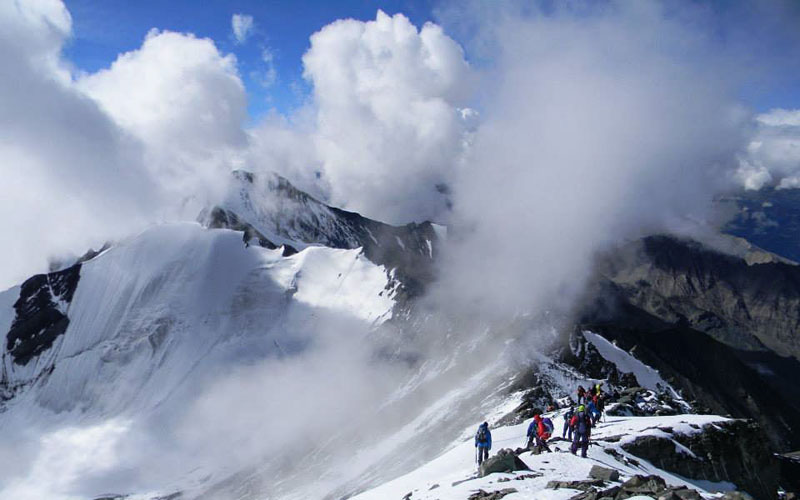
Photo by Alberto Bertotto
What gear do you need for Stok Kangri?
An expedition like Stok Kangri requires some specific gear.
To make sure you don’t forget to bring anything, this is a recommended list of gear to pack, based on our own experience.
Travel Gear
- Passport and a valid visa are obvious ones. Check with your travel agent or the nearest India High Commission to see what the requirements are for your country’s passport but for the most part, most nationalities are required to apply for a visa prior to entry in order to visit India. The application can be done online via India’s e-visa system, or alternatively at your nearest VFS Global centre which processes visas to visit India.
- A durable and water-proof duffel bag is next on the list. Your duffel is going to be carried by porters or loaded onto a horse so it needs to be durable, comfortable to carry and able to withstand the weather - water-proofing is a must! We think that the Northface Base Camp Duffel is a winner here.
- Your lightweight daypack will come in handy as your carry-on luggage for flights and is an essential item for your trek to carry items of a personal nature that you need on a daily basis whilst trekking. This should also be waterproof or have a rain cover.
Climbing Gear
- You will need crampons that are compatible with your hiking boots. The 12- point crampons offer more traction than 10-point crampons and we like the Black Diamond Sabretooth Pro Crampons.
- A straight shaft mountaineering ice axe with wrist loop. Make sure you get the correct one for your height.
- Climbing harness and two locking and non-locking carabiners in case you need to rope up for the walk along the ridge to the summit.
- A climbing helmet
Clothing & Accessories
Footwear
- Hiking boots that fit your crampons and are waterproof – either B1 or B2 boots will be fine.
- Lightweight hiking boots – daytime temperatures can be warmer in Ladakh so bring a pair suitable for this.
- A pair of comfortable trainers and/or sandals to wear around camp at night.
- Woollen mountaineering socks for the summit.
- Synthetic/lightweight woollen socks for trekking.
- A pair of gaiters to keep boots and lower legs dry in case of wet and snowy conditions
Lower Body Layers
- Water and windproof hiking trousers.
- Thermal base underlayer.
- Insulated trousers for wearing around camp.
- Trekking pants and shorts – should be lightweight and synthetic.
Upper Body Layers
- Water and windproof hiking jacket.
- Quick-dry hiking T-shirts.
- Mid to heavyweight fleece jacket
- Thermal base underlayer. We recommend Smartwool's range of base layers.
- Medium weight down jacket.
Headgear and Handwear
- Waterproof gloves
- Fleece/woollen gloves
- Wide brim sun hat
- Woollen/fleece warm hat or balaclava for summit day.
- Buff and/or scarf for protection from dust.
- Sunglasses with ample UV protection.
- Headlamp with extra batteries.
Other Essentials
- Sleeping bag and mat.
- Dry bags to arrange your gear and keep it dry.
- Trekking poles are highly recommended for this trek – try the Black Diamond Alpine Carbon Cork.
- 2 wide mouth water bottles. The Nalgene Tritan BPA Free Bottle will not freeze up in cold temperatures unlike metal bottles or hydration bladders.
- Insulated bottle cover to keep your liquids hot or cold.
- Water purification tablets
- Snacks such as energy bars or dried fruit to keep you fuelled between meals.
Accessories
- High SPF Sun cream and lip balm.
- Wet wipes, hand sanitizer and tissues.
- Soap, toothbrush and toothpaste, wash towel.
- First aid kit including painkillers, insect repellent, hydration salts, plaster and blister treatment, diarrhoea treatment. Speak to your doctor about Diamox for altitude sickness.
- Penknife
- Camera and extra batteries.
- Repair kit – needle and thread, duct tape
See our full gear list for more details.
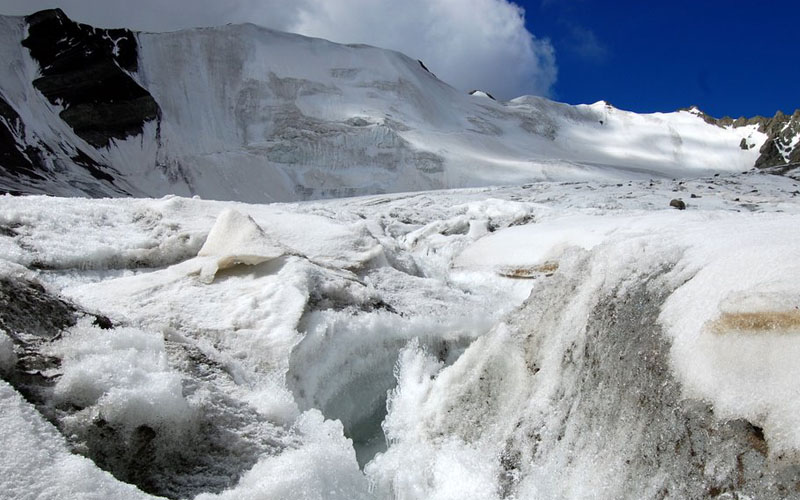
Photo by Mark Horrell
How much does it cost to climb Stok Kangri?
There are various budgets available to Stok Kangri trekkers and the cost will depend on what you choose to include in your trek.
Booking with a guiding company will vary greatly in price, for example, some will include flights between Delhi and Leh, while others will only cater for your trip from Leh onwards. At a glance though, most packages will include your accommodation in Leh, camping and meals whilst on your trek, fees for the necessary support staff, permits and entry fees for the trek. These start from about US$2500 per person and can go up to US$3,150 for a package that has a longer itinerary and includes your flights between Delhi and Leh.
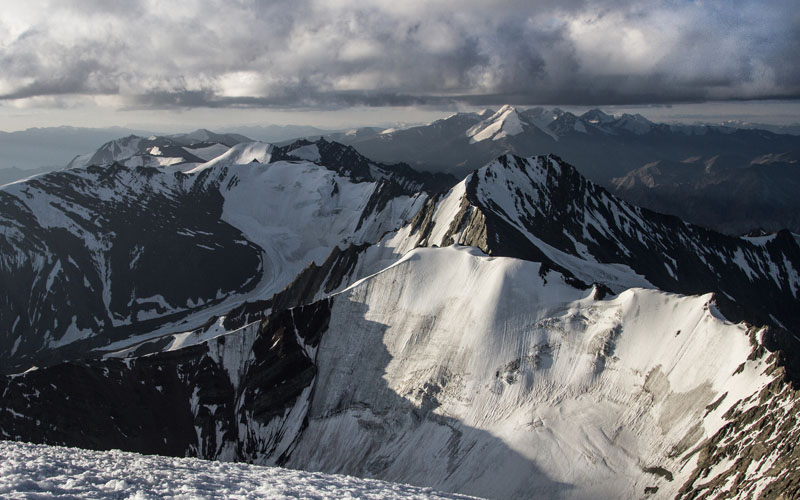
Photo by Kuntal Joisher
Do you need a permit to climb Stok Kangri?
Yes, you do. If you plan your trek through a guiding company, then all of your relevant permits for the trek are usually included in your package price.
If you are an experienced trekker, opt to do your own expedition up the mountain. To do that, you will need to get an IMF (Indian Mountaineering Foundation) permit which costs about US$50 for foreign nationals and can be purchased in Leh.
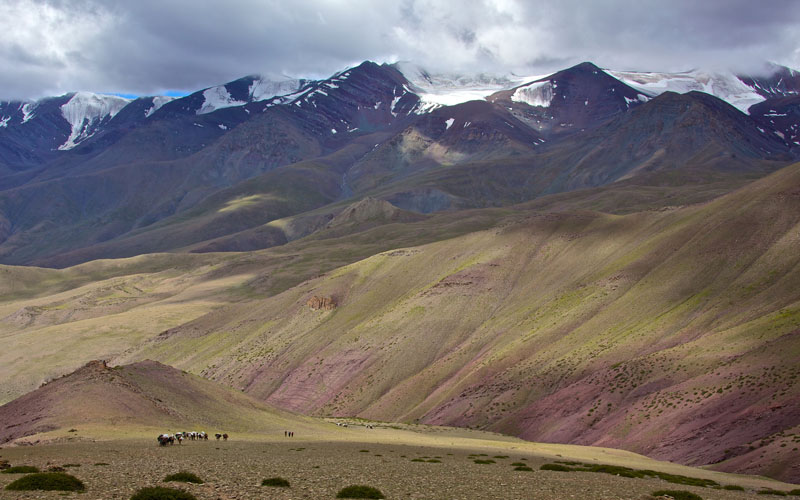
Photo by Tina Iyer
Do you need insurance for Stok Kangri?
Any high-altitude mountain expedition is considered risky, and you will need to get comprehensive hiking insurance to cover you. If you have booked your trek with a guiding company, then standard travel insurance will not cover high altitude mountaineering. When booking your trek, ask your tour provider for their recommendations on high altitude travel insurance providers.
We recommend contacting the BMC in the UK or the American Alpine Club in the US for more information on trekking insurance.
Continue browsing...
See more information on India. Or check out these other Asian Hiking articles:

